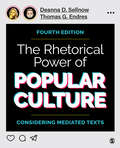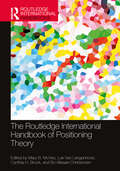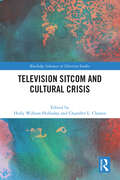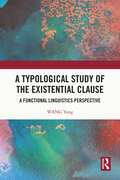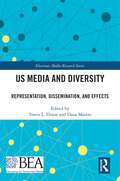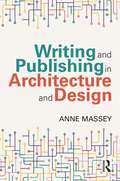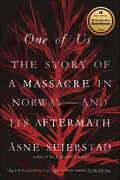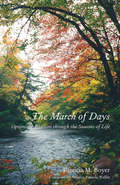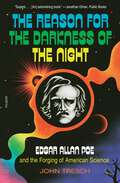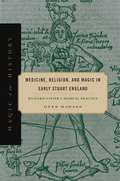- Table View
- List View
The Rhetorical Power of Popular Culture: Considering Mediated Texts
by Deanna D. Sellnow Thomas G. EndresCan television shows like Stranger Things, popular music by performers like Taylor Swift, advertisements for products like Samuel Adams beer, and films such as The Hunger Games help us understand rhetorical theory and criticism? The Fourth Edition of The Rhetorical Power of Popular Culture offers students a step-by-step introduction to rhetorical theory and criticism by focusing on the powerful role popular culture plays in persuading us as to what to believe and how to behave. In every chapter, students are introduced to rhetorical theories, presented with current examples from popular culture that relate to the theory, and guided through demonstrations about how to describe, interpret, and evaluate popular culture texts through rhetorical analysis. Authors Deanna Sellnow and Thomas Endres provide sample student essays in every chapter to demonstrate rhetorical criticism in practice. This edition’s easy-to-understand approach and range of popular culture examples help students apply rhetorical theory and criticism to their own lives and assigned work.
The Rhetorical Power of Popular Culture: Considering Mediated Texts
by Deanna D. Sellnow Thomas G. EndresCan television shows like Stranger Things, popular music by performers like Taylor Swift, advertisements for products like Samuel Adams beer, and films such as The Hunger Games help us understand rhetorical theory and criticism? The Fourth Edition of The Rhetorical Power of Popular Culture offers students a step-by-step introduction to rhetorical theory and criticism by focusing on the powerful role popular culture plays in persuading us as to what to believe and how to behave. In every chapter, students are introduced to rhetorical theories, presented with current examples from popular culture that relate to the theory, and guided through demonstrations about how to describe, interpret, and evaluate popular culture texts through rhetorical analysis. Authors Deanna Sellnow and Thomas Endres provide sample student essays in every chapter to demonstrate rhetorical criticism in practice. This edition’s easy-to-understand approach and range of popular culture examples help students apply rhetorical theory and criticism to their own lives and assigned work.
The Routledge International Handbook of Positioning Theory (Routledge International Handbooks)
by Luk Van Langenhove Cynthia H. Brock Mary B. McVee Bo Allesøe ChristensenThis handbook is the first of its kind to explore Positioning Theory. Taking inspiration from the groundwork set by Rom Harré and collaborators such as Bronwyn Davies, Fathali Moghaddam, Luk Van Langenhove, and others the book explores the emergence, historical context, and disciplinary applications of Positioning Theory and its basic precepts as a social psychological theory.This volume encompasses over 20 chapters across four sections, assimilating cross-disciplinary insights that try to understand the theoretical underpinnings, methodological applications, and contemporary relevance of Positioning Theory. Part 1 explores the movement of scholarly figures and their numerous works on the subject. It discusses the foundational origins and the historical contexts of the existing theories on positioning and new directions for scholarship. Part 2 examines the methodological and narrative investigations used for data analysis in positioning research, navigating through the epistemological orientations and theoretical landscapes of Positioning Theory. Part 3 explores numerous applications across disciplines to consider the reach and influence of positioning within and across multiple disciplines. Lastly, the authors contemplate the future directions for Positioning Theory.Featuring researchers from leading research institutions from across the globe, the book is important reading for scholars interested in positioning and Positioning Theory. We recommend this handbook for graduate-level courses in social psychology, communication, discourse studies and related disciplines.
Television Sitcom and Cultural Crisis (Routledge Advances in Television Studies)
by Holly Willson Holladay Chandler L. ClassenThis volume demonstrates that television comedies are conduits through which we might resist normative ways of thinking about cultural crises.By drawing on Gramscian notion of crisis and the understanding that crises are overlapping, interconnected, and mutually constitutive, the essays in this collection demonstrate that situation comedies do more than make us laugh; they also help us understand the complexities of our social world’s moments of crisis. Each chapter takes up the televisual representation of a modern cultural crisis in a contemporary sitcom and is grounded in the extensive body of literature that suggests that levity is a powerful mechanism to make sense of and cope with these difficult cultural experiences.Divided into thematic sections that highlight crises of institutions and systems, identity and representation, and speculation and futurism, this book will interest scholars of media and cultural studies, political economy, communication studies, and humor studies.
A Typological Study of the Existential Clause: A Functional Linguistics Perspective
by Wang YongThis book investigates the existential clause (EC) from a cross-linguistic perspective and within the framework of Systemic Functional Linguistics.The prototypical EC in the less familiar languages is identified through its functional equivalents in the more familiar ones, which share the common semantic basis of ‘there exists something in some location’. Topics addressed include the morpho-syntactic features of the EC, the subject of the EC, the definiteness effect and its manifestations in the EC, the EC as impersonals, the distinction between entity- vs. event-existentials, and the EC and its related constructions. Drawing on both cross-linguistic observations based on the language sample and in-depth investigations in particular languages (e.g., in Chinese and English), the study aims to unravel how the lexico-grammar of EC is related to its meanings and functions, that is, how meaning is realised in form.The title will appeal to scholars and students in the field of linguistics, especially functional linguistics, and syntax.
US Media and Diversity: Representation, Dissemination, and Effects (ISSN)
by Travis L. DixonThis volume fully illuminates the role of diversity in media representation, dissemination, and effects across various platforms, including social media. Against a backdrop of shifting demographics and increasing diversity, the book highlights the implications for media consumption patterns and explores the simultaneous rise in online hate.Organized into three thematic sections, the book first centers people of color in the discussion of media stereotypes and identity, considering the impact of technology on such identities. This volume then moves to analyze the news media, and how stereotypes are presented and perpetuated, before focusing on paradigm shifts brought on by critical media effects and counter-stereotyping research. The empirical studies and theoretical analyses push readers to imagine better how Communication scholars can advance this essential work at a precarious time in history.Budding and senior scholars interested in understanding stereotypical media representations and effects will gain insights from this critical and timely book, and it will interest those working in the areas of media and communication, media representation, social justice, diversity and inclusion, media sociology, social media, and journalism.
Writing and Publishing in Architecture and Design
by Anne MasseyThis book outlines the process of writing and publishing research in the field of architecture and design. The book sets out to help researchers find a voice and find the best fit for their work. Information about the different types of publication on offer is set out, as well as how to make that important initial approach. From pitching an idea for a review in a magazine, to producing a journal article right through to the monograph, Writing and Publishing in Architecture and Design maps out the different steps for the novice author. Your first steps in publishing can be daunting, and the book offers material which will inspire confidence, by demystifying the publication process. It also includes valuable nuts and bolts material such as planning and structure, time management, writing styles, editing, production of the final manuscript and picture research. How do you turn your PhD into a book? How do you turn conference proceedings into a publication? Commissioning editors and authors share their experiences through interview and offer recipes for success as well as what to avoid. Key titles from the past are included as case studies, and their pathway to publication explored. This is an invaluable book for anyone working in the fields of architecture and design, with an ambition to publish.
One of Us: The Story of a Massacre in Norway—and Its Aftermath
by Åsne SeierstadOne of The New York Times Book Review's Ten Best Books of 2015 and a New York Times bestseller, and now the basis for the Netflix film 22 July, from acclaimed filmmaker Paul Greengrass Widely acclaimed as a masterpiece, Åsne Seierstad’s One of Us is essential reading for a time when mass killings are so grimly frequent. On July 22, 2011, Anders Behring Breivik detonated a bomb outside the Norwegian prime minister's office in central Oslo, killing eight people. He then proceeded to a youth camp on the wooded island of Utøya, where he killed sixty-nine more, most of them teenage members of the country's governing Labour Party. In One of Us, the journalist Åsne Seierstad tells the story of this terrible day and its reverberations. How did Breivik, a gifted child from an affluent neighborhood in Oslo, become Europe's most reviled terrorist? How did he accomplish an astonishing one-man murder spree? And how did a famously peaceful and prosperous country cope with the slaughter of so many of its young? As in her international bestseller The Bookseller of Kabul, Seierstad excels at the vivid portraiture of lives under stress. She delves deep into Breivik's childhood, showing how a hip-hop and graffiti aficionado became a right-wing activist, a successful entrepreneur, and then an Internet game addict and self-styled master warrior who believed he could save Europe from the threat of Islam and multiculturalism. She writes with equal intimacy about Breivik's victims, tracing their political awakenings, teenage flirtations and hopes, and ill-fated journeys to the island. By the time Seierstad reaches Utøya and relates what happened there, we know both the killer and those he will kill. In the book's final act, Seierstad describes Breivik's tumultuous public trial. As Breivik took the stand and articulated his ideas, an entire country debated whether he should be deemed insane, and asked why a devastating sequence of police errors allowed one man to do so much harm.One of Us is at once a psychological study of violent extremism, a dramatic true crime procedural, and a compassionate inquiry into how a privileged society copes with homegrown evil. Lauded in Scandinavia for its literary merit and moral poise, One of Us is the true story of one of our age's most tragic events.
The March of Days: Optimistic Realism through the Seasons of Life
by Patricia M. BoyerAlthough Patricia M. Boyer won a scholarship to McMaster University with the highest mathematics marks in Ontario and graduated at age 19, literature and languages were her specialty. She first worked as a public librarian, next as a secondary school teacher, then as a newspaper editor. A community leader in arts and theatre, Patricia was devoted to human rights action in her local community and around the world, church work, drama, the education of children with disabilities, and music. Each week she wrote a newspaper column inspired by episodes in the world around her, both local and global. She rewarded readers through articles infused with learning from literature, astute sensibility to human psychology, and balanced insights on the tragedies and comedies of life’s passing parade. Patricia Boyer summed up her approach to life as "optimistic realism". This collection of the best of her celebrated columns, organized through the twelve months of the year or "the march of days", includes reflections on seasonal celebrations, changing atmospheres of nature, and calendar milestones in the human cycle. A number of these concise yet poignant writings will move many readers with nostalgia as they evoke the happy events and tragic developments of the Sixties and Seventies. All of them, however, convey the wisdom of a woman whose message of optimistic realism endures like a timeless guide to living a satisfying life in the real world today.
The Reason for the Darkness of the Night: Edgar Allan Poe and the Forging of American Science
by John TreschOne of The Christian Science Monitor's ten best books of JuneAn innovative biography of Edgar Allan Poe—highlighting his fascination and feuds with science.Decade after decade, Edgar Allan Poe remains one of the most popular American writers. He is beloved around the world for his pioneering detective fiction, tales of horror, and haunting, atmospheric verse. But what if there was another side to the man who wrote “The Raven” and “The Fall of the House of Usher”?In The Reason for the Darkness of the Night, John Tresch offers a bold new biography of a writer whose short, tortured life continues to fascinate. Shining a spotlight on an era when the lines separating entertainment, speculation, and scientific inquiry were blurred, Tresch reveals Poe’s obsession with science and lifelong ambition to advance and question human knowledge. Even as he composed dazzling works of fiction, he remained an avid and often combative commentator on new discoveries, publishing and hustling in literary scenes that also hosted the era’s most prominent scientists, semi-scientists, and pseudo-intellectual rogues. As one newspaper put it, “Mr. Poe is not merely a man of science—not merely a poet—not merely a man of letters. He is all combined; and perhaps he is something more.”Taking us through his early training in mathematics and engineering at West Point and the tumultuous years that followed, Tresch shows that Poe lived, thought, and suffered surrounded by science—and that many of his most renowned and imaginative works can best be understood in its company. He cast doubt on perceived certainties even as he hungered for knowledge, and at the end of his life delivered a mind-bending lecture on the origins of the universe that would win the admiration of twentieth-century physicists. Pursuing extraordinary conjectures and a unique aesthetic vision, he remained a figure of explosive contradiction: he gleefully exposed the hoaxes of the era’s scientific fraudsters even as he perpetrated hoaxes himself. Tracing Poe’s hard and brilliant journey, The Reason for the Darkness of the Night is an essential new portrait of a writer whose life is synonymous with mystery and imagination—and an entertaining, erudite tour of the world of American science just as it was beginning to come into its own.
Medicine, Religion, and Magic in Early Stuart England: Richard Napier's Medical Practice (Magic in History)
by Ofer HadassThe astrologer-physician Richard Napier (1559-1634) was not only a man of practical science and medicine but also a master of occult arts and a devout parish rector who purportedly held conversations with angels. This new interpretation of Napier reveals him to be a coherent and methodical man whose burning desire for certain, true knowledge contributed to the contemporary venture of putting existing knowledge to useful ends.Originally trained in theology and ordained as an Anglican priest, Napier later studied astrological medicine and combined astrology, religious thought, and image and ritual magic in his medical work. Ofer Hadass draws on a remarkable archive of Napier’s medical cases and religious writings—including the interviews he claimed to have held with angels—to show how Napier’s seemingly inconsistent approaches were rooted in an inclusive and coherent worldview, combining equal respect for ancient authority and for experientially derived knowledge. Napier’s endeavors exemplify the fruitful relationship between religion and science that offered a well-founded alternative to the rising mechanistic explanation of nature at the time.Carefully researched and compellingly told, Medicine, Religion, and Magic in Early Stuart England is an insightful exploration of one of the most fascinating figures at the intersection of medicine, magic, and theology in early modern England and of the healing methods employed by physicians of the era.
